THE BEGINNING (Monday, 22nd October, 1956, afternoon)
Attila Lipcsey and I settle in the gallery of the auditorium. He sat nodding, I rub my green-rusty copper ring, hoping that the old beautiful yellow patina will emerge from under the rust. Down on the platform, the party secretary is talking about Poland, Attila is taking a nap, I’m rubbing the ring. We do what we do at all such meetings, let them just talk about the party, and we defend ourselves by not paying attention.
Suddenly I feel Attila’s elbow in my side. I’m paying attention. There seems to be a scuffle on the platform, the officials seem to be trying to hide a student from the microphone, but he doesn’t let go. He gets the microphone and he says that he was sent from the University of Szeged and brought the news that MEFESZ (Unified Organization of Hungarian University and College Students) was formed there in response to the events in Poland. And they ask us to create our own MEFESZ organization.
Then the atmosphere changed. The party secretary dissolved the meeting and left the hall with his staff, but none of the students moved. In fact, some people went to the microphone and asked such things as whether MEFESZ was created with a state license? Then followed a lot of typically student questions and demands about canteens, student hostels, and textbooks. It must have been 6 or 7 o’clock, there were still quite a few students in line waiting for the microphone, when a short, scared, visibly embarrassed student stepped up to the microphone. When he spoke, we already understood why he was embarrassed, because he stuttered, somehow he moaned:
“Caaan’t the Ruuussians go hooome?”
Suddenly there was deathly silence in the huge hall, you could even hear a pin drop. The same thing was going through everyone’s mind, including mine: This student has gone crazy! Doesn’t he know that he will be immediately expelled from the university? Doesn’t he know he’ll never become an engineer? In fact, it’s a good thing they don’t arrest him! We wait with bated breath to hear what else he has to say, but he just kept silent, terrified. And then, somewhere above, the soft voice of a student girl is heard from the wide rows of the gallery. Frightened, she begins to sing the National Anthem almost without melody. The silence is still deadly, we still just listen in amazement, but now something starts: The two-meter-tall Jancsi Danner (who later became the first heroic death of the Technical University) stands up and now his firm voice joins the voice of the young woman. And then, just as the first drops of a summer thunderstorm are suddenly followed by a shower, here and there one student stands up, the shock passes and finally we stand up too. And by the time we get to the “bad fate” in the song, the three or four thousand university students are singing so loud that the windows shake. The huge chandeliers in the hall also vibrate, while we sing our national prayer together with full throats, teary eyes, and a tense posture of vigilance.
It was as if a miracle had happened! We, the previously fearful and vulnerable students, were almost reborn. We saw that no one was left sitting in the room. We became aware that we are not alone, that everyone is thinking in unison, and this awareness made us strong at the same time. This anthem was like some kind of joint oath that eliminated fear. Yes, that’s when the revolution broke out! That was when the all-embracing and indivisible unity was born, which permeated the following days, made the spirit of 1956 great and noble, and left a mark on our souls for life.

This is how we set off for Bem Square the next day. We, third-year machinists, led the parade. In the first row, Nándi Kiefer puts his arm around me, Pali Szilágyi on my other side and Andris Gróf behind him, (who later became Andy Grove in the United States and was the founder and owner of Intel.)
THE END (16th June, 1958, dawn)
It’s barely dawn, only three mourners from Csömör are working in the yard of the collection prison, digging a hole in the hard-trodden ground. Not far from them, on the already concreted part, there stands a gallows ladder and a small stool in front of it. To the left of that is a small table with medical instruments on it, and next to the table is a doctor in a white coat, next to him is a Russian and a Hungarian observer and the ÁVH officer supervising the three. Then the four-member hanging squad exits the building. They are also ÁVÓ members: the commander, the executioner and the other two. The task of the two lower ranks will be to pull the stool out from under Imre Nagy’s feet.
They barely speak to each other, only watching the door from the building to the courtyard. Then the door opens and Imre Nagy steps out with his head held high and his hands cuffed. The day before, after his sentence was announced, he submitted his farewell letters to his family (which have not been found so far) in front of Judge Ferenc Vida and in total he said:
“I don’t want to raise anything in my defense, I don’t ask for mercy!”
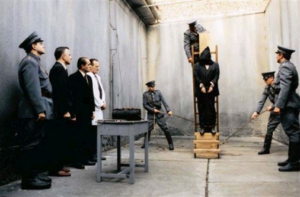
When the executioner (János Bogár) pulled the noose over his head, he accidentally knocked off Imre Nagy’s glasses. Imre Nagy spoke to him in a calm, firm voice:
“Please put my glasses back, I can’t because of the handcuffs!”
“Yes, Sir, indeed!” – answered the executioner.
He put on his glasses and now more carefully pulled the hanging bag over his head again, then led him to the hanging stool, he himself climbed the hanging ladder and at 5:09 a.m., on the instructions of the ÁVH commander, put the rope around Imre Nagy’s neck. Then the command was given: “Pull out a stool!” and Nagy followed the historic path of Lajos Batthyány.
After the doctor established that Imre Nagy had died, the doctor accepted the 120 forint fee for writing a death certificate, signed the receipt confirming the receipt of the money (the issuance of which acknowledgment was required by the laws of the Hungarian “rule of law”), General Pál Maléter followed. Both he and Miklós Gimes died with dignity and with their heads held high. The hanging ended around 6 a.m, but the mourners were still digging the second burial grave.
The soil in the prison yard was hard, and the work of the grave diggers progressed slowly. When the ÁVH officers wrapped the bodies in tar paper and tied them with wire, only two burial pits were ready. “No problem,” said the ÁVH officer, “that’s enough.” They then threw the body of Imre Nagy face down into one of them. His light glasses with metal frames fell on the concrete while being carried and cracked. They also threw that into the pit. Then, the other two corpses were thrown into the second prepared pit. General Maléter fell to the bottom, and the corpse of Miklós Gimes was thrown on top of him.
When the news of the murder reached us, already living in the New York area, Gyuri Lovas climbed a flagpole standing in front of the UN and tore the Hungarian flag from it, and several of us went to prison for trying to occupy the Russian consulate.
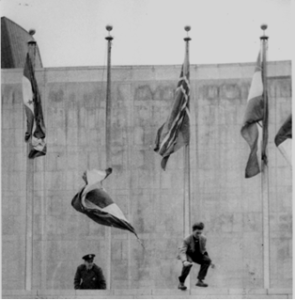
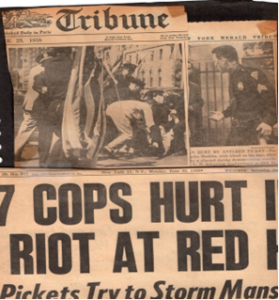
Imre Nagy, Pál Maléter and Miklós Gimes lay in the two burial pits in the yard of the prison for three years and only on the night of February 24, 1961 were they transferred to plot 301 of the public cemetery. There, too, only two grave pits were given to the three of them and, of course, false names were entered in the cemetery register: Imre Nagy’s grave was registered under the name Piroska Borbiró, and the common grave of Pál Maléter and Miklós Gimes was registered under the pseudonym Péter Naszladi. That is why, when the bodies were exhumed, Imre Nagy was found in pit 8 of row 23, and Pál Maléter and Miklós Gimes were found next to him in pit 9 of row 23. Here again Pál Maléter was at the bottom and together with Miklós Gimes, they were both thrown face down into the pit.
Well, the revolution really ended in 1958, with the hanging of Imre Nagy. Yes, only blood and executions remained from the 1956 unit and the slogan “those who are Hungarian are with us”. Imre Nagy did not receive as much as Lajos Batthyány, because in 1849 it was not a Hungarian but an Austrian bullet that ended his life, while Imre Nagy’s executioners were Hungarian. And while Lajos Batthyány’s perpetual flame still stands today, the statue of Imre Nagy was moved, surreptitiously in in the middle of the night from a park directly across from the Parliament to Jászai Mari Square on December 28, 2018.
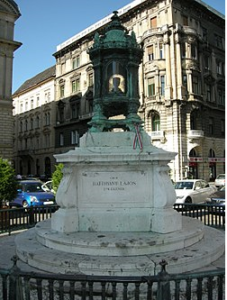
The last veteran of 1948 was still alive when the Batthyány eternal candlestick was moved to its current location in 1926, and since then no one has ever moved it from there.
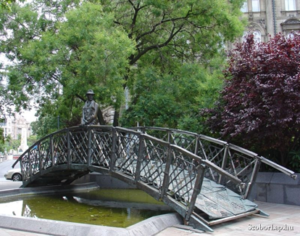
The statue was inaugurated on June 6, 1996 and stood in place for 22 years. The statue is the work of Tamás Varga. Uncle Imre looks at the Hungarian Parliament from the light-year bridge under the leafy trees. Then came the night of December 28, 2018, and his statue was moved to Jászay Mari Square, where it now only faces a parked car.
Béla Lipták







